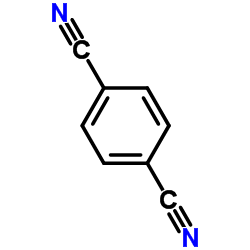Terephthalonitrile

Terephthalonitrile structure
|
Common Name | Terephthalonitrile | ||
|---|---|---|---|---|
| CAS Number | 623-26-7 | Molecular Weight | 128.131 | |
| Density | 1.2±0.1 g/cm3 | Boiling Point | 289.6±23.0 °C at 760 mmHg | |
| Molecular Formula | C8H4N2 | Melting Point | 221-225 °C(lit.) | |
| MSDS | Chinese USA | Flash Point | 142.8±16.5 °C | |
|
Mechanism of back electron transfer in an intermolecular photoinduced electron transfer reaction: solvent as a charge mediator.
ChemPhysChem 15(14) , 2945-50, (2014) Back electron transfer (BET) is one of the important processes that govern the decay of generated ion pairs in intermolecular photoinduced electron transfer reactions. Unfortunately, a detailed mechanism of BET reactions remains largely unknown in spite of th... |
|
|
A study of a moleculartweezer host-guest system by a combination of quantum-chemical calculations and solid-state NMR experiments.
Solid State Nucl. Magn. Reson. 22(2-3) , 128-53, (2002) A study of a host-guest system consisting of a naphthalene-spaced tweezer with a 1,4 dicyanobenzene guest molecule is presented. The complex is investigated using a combination of quantum-chemical calculations and solid-state NMR experiments. The advantages o... |
|
|
Thermal degradation of polyester coating powders: 1,4-dicyanobenzene as an occupational marker compound.
Analyst 114(9) , 1009-12, (1989) A method for the determination of emissions in workroom air as a result of the thermal degradation of polyester coating powders is described. The method is based on the determination of certain marker compounds only. Polyester coating powders were degraded th... |
|
|
Metallization of ultra-thin, non-thiol SAMs with flat-lying molecular units: Pd on 1, 4-dicyanobenzene.
ChemPhysChem 11(13) , 2951-6, (2010) Self-assembled monolayers of 1,4-dicyanobenzene on Au(111) electrodes are studied by cyclic voltammetry, in-situ STM and ex-situ XPS. High-resolution STM images reveal a long-range order of propeller-like assemblies each of which consists of three molecules, ... |
|
|
Synthesis and photophysics of novel 8-hydroxyquinoline aluminum metal complex with fluorene units.
Spectrochim. Acta. A. Mol. Biomol. Spectrosc. 68(3) , 646-50, (2007) A novel luminescent metal complex, (MQPF)3Al2, with 8-hydroxyquinoline aluminum and 9,9-diphenylfluorene was synthesized. The optical properties were investigated by UV-vis absorption and fluorescence emission spectra. The results showed that the luminescence... |
|
|
Magnetic field effect on the exciplex between all-s-trans- 1,4-diphenylbuta- 1,3-diene and 1,4-dicyanobenzene: a comparative study with other alpha,omega-diphenyl polyenes.
Spectrochim. Acta. A. Mol. Biomol. Spectrosc. 57A(5) , 1103-10, (2001) The exciplex between all-s-trans-1,4-diphenylbuta-1,3-diene and 1,4-dicyanobenzene has been studied by steady state fluorescence along with the magnetic field effect (MFE) and compared with the other alpha,omega-diphenyl polyenes. The exciplex formation and m... |
|
|
Influence of steric factors on exciplex energy and magnetic field effect.
Spectrochim. Acta. A. Mol. Biomol. Spectrosc. 60(1-2) , 97-102, (2004) With the advent of spin chemistry, magnetic field effect (MFE) on exciplex luminescence has emerged as an important domain of research. MFE is a diffusion controlled phenomenon and hence is solvent dielectric (epsilon) dependent. It maximizes at a particular ... |